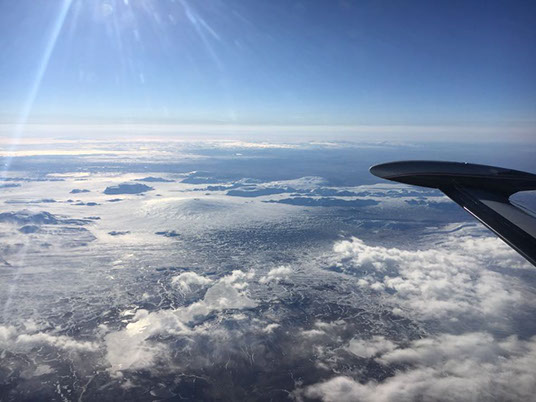At Eclipse Aerospace, we believe it’s our responsibility to equip our pilots with the knowledge necessary to safely operate the Eclipse 550. Not only did we build a jet with an incredibly intuitive flight management system, we built one of the most in-depth training programs of any aircraft manufacturer. This includes thorough and complete training on the avionics of the aircraft, resource management, risk avoidance, and how to maintain situational awareness at all times.
It doesn’t matter what you fly now; all you need to pilot the Eclipse 550 is a multi-engine and instrument rating. Our world-class training program will teach you the rest. If you are new to jet aircraft and have fewer flight hours, we will personally help you make the transition. If you are a high-time professional pilot, the transition course will be quick and easy with minimal hassle.
Whether you plan to pilot your own aircraft or fly as a passenger, an Eclipse Jet training package comes standard with every purchase of the Eclipse 550. It’s just another way we reduce your cost of ownership.
For more information, please contact training@eclipse.aero.
-
PRE-REQS
Before You Begin Your Training
Pilots are required to possess a Private Pilot Certificate with Instrument-Airplane Land rating, and a Third Class Airman Medical Certificate to enter the Eclipse Jet Type Rating course. You may perform your multi-engine rating in the Eclipse Jet. EAI recommends obtaining your multi-engine rating prior to training in the Eclipse Jet.
The prerequisites to the type rating training focus on a basic knowledge foundation for high altitude flight in turbojet aircraft, skill assessment to determine readiness for type rating training, and preparation for emergency situations, which may be encountered during turbojet operation.

JET BASICS
FLYING SKILLS
ASSESSMENT
EMERGENCY SITUATION
TRAINING

The Eclipse Flight Skills Assessment evaluates a pilot’s readiness to begin type-rating training in the Eclipse Jet by assessing the candidate’s basic instrument skills. The Flight Skills Assessment is performed in your current aircraft, by a Flight Instructor of your choice, in coordination with EAI. EAI may perform this assessment in the Eclipse Jet as an alternative. The Flight Skills Assessment criterion is equivalent to an instrument proficiency check.
Exemptions to the Flight Skills Assessment
The pilot may be exempt from the Flight Skills Assessment if he/she meets either of the following instrument currency requirements:
Instrument Proficiency Check or equivalent: Within the past 6 months
Instrument flight time last 90 days: 5 hours
Instrument approaches last 90 days: 10
The Emergency Situation Training Program is comprised of Upset Recovery Training and Aviation Physiology Training. Emergency Situation Training augments traditional aircraft type training in ways that can better prepare pilots for unexpected situations and substantially influence the probability of safe outcomes. EST is designed to provide Eclipse Jet pilots the information and experience required to deal with situations involving an unexpected aircraft upset or a loss of pressurization.
Upset Recovery Training will be conducted by third party training organizations authorized by EAI. These training organizations comply with the EAI requirements as well as the upset training guidelines in FAA Advisory Circular 61-137A. Students may select the authorized training organization that best suits their needs.
Aviation Physiology Training may be completed through an online / DVD course covering the appropriate subjects.
Exemptions to Emergency Situation Training
The pilot may be exempt from either or both components of Emergency Situation Training if he/she presents evidence of recent completion of equivalent training.
-
INITIAL
Your Initial Type Training
The ground school portion of the Eclipse Jet Type Rating course includes classroom instruction, and cockpit procedures training. Knowledge training subjects will include aircraft systems and automation, single pilot resource management, risk management, personal minimums, and aircraft performance planning.
The classroom training may also be accomplished through an online computer based training program provided by Eclipse Aerospace or Simcom Training Centers.
Cockpit Procedures Training demonstrates normal and abnormal operation of Eclipse Jet systems and automation. Instructors may conduct the cockpit procedures training in a training device, or the actual airplane.
The typical type-rating course includes a minimum of eight lessons in the aircraft, or simulator. The flight training starts slow and methodically builds in complexity. In the introduction flight the pilot will learn visual maneuvers such as Takeoffs and Landings. Towards the completion of training the pilot will gain experience in simulated abnormal situations including, wind shear recovery, engine failures, and other malfunctions. At the conclusion of training the pilot will demonstrate their proficiency of the type rating practical test standards to an Examiner. dA typical check ride profile consists of the following events.
Takeoff / Departures
Steep Turns
Stalls
Unusual Attitudes
Precision Approach – 2 Engines – to a missed approach
Non-Precision Approach – 2 Engines – to a missed approach
Non-Precision Approach to a Circle to land maneuver
Simulated Engine failure on takeoff
Precision Approach – Simulated Single Engine – to a missed approach
Precision Approach – Simulated Single Engine – to a full stop landing
Simulator training is performed at Simcom Training Center Park South location in Orlando, FL. For pilot’s choosing in-aircraft training the primary locations are Albuquerque International Sunport in Albuquerque, NM and Chicago Executive Airport in Wheeling, IL. EAI may conduct initial type training in other airport locations as required.
-
MENTORING
Custom Features for Enhanced Performance
The Eclipse 550 offers features and technologies that other light jets can only dream about. Features that enhance efficiency in order to lower the cost of ownership. The Eclipse 550 also offers the most robust set of safety features available in the light jet market, and all in the only twin-engine jet available for under $3MM.
Auto ThrottlesVirtual CopilotTwin-Engine SafetyStandby Display Unit
Standard Features on the Eclipse 550
The Eclipse 550 Base Price is $2,995,000 USD with the following standard configuration:
Dual Avio Integrated Flight Management System
Anti-Skid Brake System
Standby Display Unit (Pilot)
PPG Glass Windows
RVSM eligible
Electronic display of Jeppesen terminal procedures
Nav-source selection integration to PFDs
Autopilot coupled guidance
Flight plan overlay on Nav Displays
XM Weather integration on moving map
GPS WAAS and LPV approach capability
5-seat configuration
Premium Interior
Deluxe two-tone paint color option selected by Buyer from standard selections
Custom Paint Schemes available upon request.
Eclipse 550 Additional Benefits
60-month / 1,000 hour Eclipse Factory Warranty
60-month Eclipse Advantage Maintenance Program
P&WC Gold ESP Paid Current at Time of Delivery
Sun visors, 110v outlets, tray tables, and cupholders
One (1) initial type rating training course (SimCom or Eclipse factory direct)
One (1) year Jeppesen subscription service (US only)
Standard documentation to include Aircraft Flight Manual and Aircraft Maintenance Manual
All factory mandatory Service Bulletins complete
Optional Features for the Eclipse 550
Terrain Awareness and Warning System (TAWS)
Traffic Advisory System (TAS)
Weather Radar System (Color)
Copilot Package (2nd Quick Don Mask, 40 ft³ O² tank)
Auto Throttles
Stormscope
Standby Display Unit (Copilot)
Satellite Phone
Sixth Seat Option
Automatic Direction Finder (ADF)
Distance Measuring Equipment (DME)
Export Package (varies by country)
2nd Type Rating
Complete Feature Details
Request More Information
-
DIFFERENCES
Differences: Preparing for Your Jet
Eclipse 550 Differences Training is required for those pilots transitioning from earlier versions of the Eclipse Jet intending to fly as PIC in the Eclipse 550.
The only prerequisite for this training is a basic understanding of GPS WAAS concepts and capabilities, to include the various types of instrument approaches capable of being flown.
This course is organized into three components: classroom training, cockpit procedures training, and flight training. Ground training will describe and explain the systems that are new to the Eclipse 550 pilot such as Auto-Throttles, Anti-Skid Brakes, Dual Flight Management Systems, etc. Cockpit procedures training will provide demonstration and practice on the new systems and their operation. Finally, the flight training component will allow the pilot to first practice flight operations with new systems, and then demonstrate proficiency to type rating standards.
-
RECURRENT
Recurrent: Honing Your Skills
Recurrent training is an annual requirement for all pilots who act as pilot in command of a turbojet aircraft in accordance with 14 CFR 61.58. Recurrent training involves classroom academics as well as flight sessions in an Eclipse Jet or level D simulator. The goal of recurrent training is to ensure that required knowledge and skills have not deteriorated and to stay updated on new requirements and new aircraft capabilities. Recurrent training emphasizes reinforcement of skills such as automation management, effective pre-flight planning, Single Pilot Resource Management (SRM), and risk management.
Classroom training is designed to provide the pilot with supplemental knowledge on selected topics relating to the continued safe operation of the Eclipse Jet. Knowledge training subjects will include aircraft systems review, current operational topics and safety trends, seasonal operations issues, and a review of the Flight Training and Standards Manual. Pilots will also have an opportunity to share/discuss any operating issues experienced while operating the Eclipse. EAI will update the course frequently to respond to changing operational issues.
Flight or Simulator sessions are intended to allow practice of required and selected events before finally demonstrating proficiency to the type rating practical test standards on the 61.58 proficiency check.
Simulator training is performed at Simcom Training Center Park South location in Orlando, FL. For pilot’s choosing in-aircraft training the primary locations are Albuquerque International Sunport in Albuquerque, NM and Chicago Executive Airport in Wheeling, IL. EAI may conduct recurrent training in other airport locations as requested.
-
SIMULATOR
Train in SimCom's Level-D Simulators
From their training centers located in Orlando, Florida, SimCom offers business and general aviation pilots the best quality simulator training at the best prices in the industry.
Personalized training for the Eclipse Twin-Engine Jet
No more big classes with the same scripted information every time. Classes at SimCom have a maximum of two pilots, and the information presented is driven by your interest and needs. Your classroom instructor also handles your simulator sessions, so there is consistency to your training.
State of the Art Simulators
SimCom's jet simulators will feel as familiar to you as your own aircraft because they are crafted from actual fuselage sections and original components. And our advanced, wide-screen visual system technology delivers a realistic sensation of motion. The cost-effectiveness of the SimCom technology means better value for our customers compared to other simulation training environments.
Learn more at SimCom's website, www.simulator.com.

